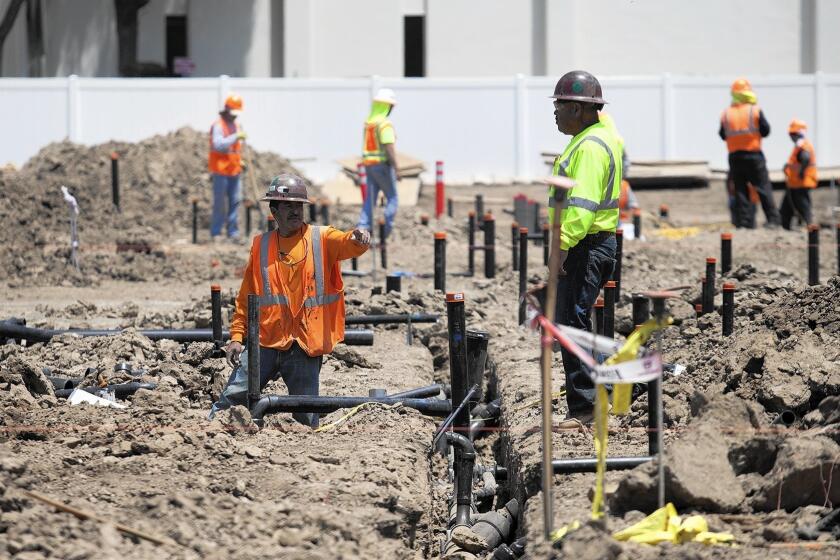Costa Mesa leaders eye rezoning L.A. Chargers training field for high-density housing

- Share via
Re-zoning part of the Hive, the Costa Mesa headquarters of the Los Angeles Chargers, for high-density housing and converting motels into permanent dwellings are among several moves being pondered as city officials prepare a housing element before an October deadline.
The Costa Mesa City Council and the city’s planning commission convened Monday in a joint study session to review a draft of the document designed to identify the city’s residential needs in the eight years ahead. A state mandate requires municipalities to update housing element plans each nine years, with 2021 to 2029 being the sixth such cycle.
However, as a statewide housing shortage continues to forestall dreams of California home ownership, state officials are pressuring cities to plan for many more residential units while using every civic strategy possible to accommodate them. Costa Mesa must plan for 11,760 additional units by 2029.
Located north of the 405 Freeway, the Hive is a 14.25-acre site owned by Atlanta-based Invesco Real Estate that includes an office complex with multiple tenants and a training field used by the football team under a 10-year lease signed in 2017.
But it could also provide a ripe opportunity for developers to build large-scale housing projects in areas slated for job growth — Invesco in February helped leased a 640,000-square-foot property nearby to defense tech company Anduril — while helping the city meet its mandate.
Officials will appeal a housing allocation that calls for Costa Mesa to plan and zone for 11,733 residential units by 2029. But new state laws are adamant cities must address California’s housing shortage.
Tim O’Brien, senior managing director for real estate firm Legacy Partners and a representative of Invesco, said his clients were open to the idea of rezoning the field portion of the Hive property.
“That’s in anticipation of the temporary nature of the Chargers’ use of that field as a practice site,” he said. “Planning for that eventuality they’d like to be included in and are prepared to advance a specific plan concurrent with the general plan. It’s a very actionable site.”
City council members and planning commissioners roundly agreed such a prospect seemed promising.
“How often do we have a piece of land like that and have the developer come in and say, ‘We’d like to have it be considered as housing?’” posed Planning Commissioner Diane Russell. “As much as I’m going to hate the idea of the Chargers not being here.”
The Hive is just one area being eyed for more development. City leaders, for example, are in talks with the state Department of Developmental Services, which owns the 109-acre Fairview Developmental Center, about opening that property to potential future development.
Other options include incentivizing the building of accessory dwelling units on single-family properties and participating in Orange County’s project Homekey — a plan to shelter homeless individuals in motel and hotel rooms during the pandemic that could morph into a permanent supportive housing.
The Costa Mesa City Council on Tuesday discussed a variety of possible solutions for accommodating the number of housing units the state says the city needs, such as an inclusionary housing ordinance, accessory dwelling units and co-living spaces.
“There are many of us on the dais who’ve heard complaints about not-so-great motels and hotels in Costa Mesa,” Councilman Manuel Chavez said. “If we can convert [them] into housing, that’s two birds with one stone.”
An inclusionary housing ordinance, which would require developers set aside a certain percentage of residential units for low- and extremely low-income occupants, is currently being studied by city staff and could come up for a vote by or before October 2022, according to Jennifer Le, the city’s director of economic and development services.
“This is something we’ve already started on,” Le said. “We need to prioritize getting the housing element submitted to the state. But certainly, we expect the inclusionary housing ordinance to follow shortly after.”
It is still unclear how proposals put forth in the city’s housing element will nexus with Measure Y, passed in 2016, that requires voter approval of large-scale zone changes or developments beyond a certain threshold. Anticipating such standoffs in local communities, state lawmakers are working to make mandated housing allocation plans exempt from such local measures.
Le told council members and commissioners the draft of the new housing element would be submitted to the state Housing and Community Development Department by Oct. 15, upon which the agency would have 60 days to review and comment on the document.
After that, Costa Mesa will have until Feb. 11 to hold public hearings at the council and commission level, make any amendments and submit a final version of the plan.
“We’re not building these for the growth of the city. We’re building these units for the residents who are here,” Mayor John Stephens said of the proposal. “We have a small supply of housing and it’s causing the cost of housing to go up. The way to deal with that is to increase the supply.”
All the latest on Orange County from Orange County.
Get our free TimesOC newsletter.
You may occasionally receive promotional content from the Daily Pilot.





